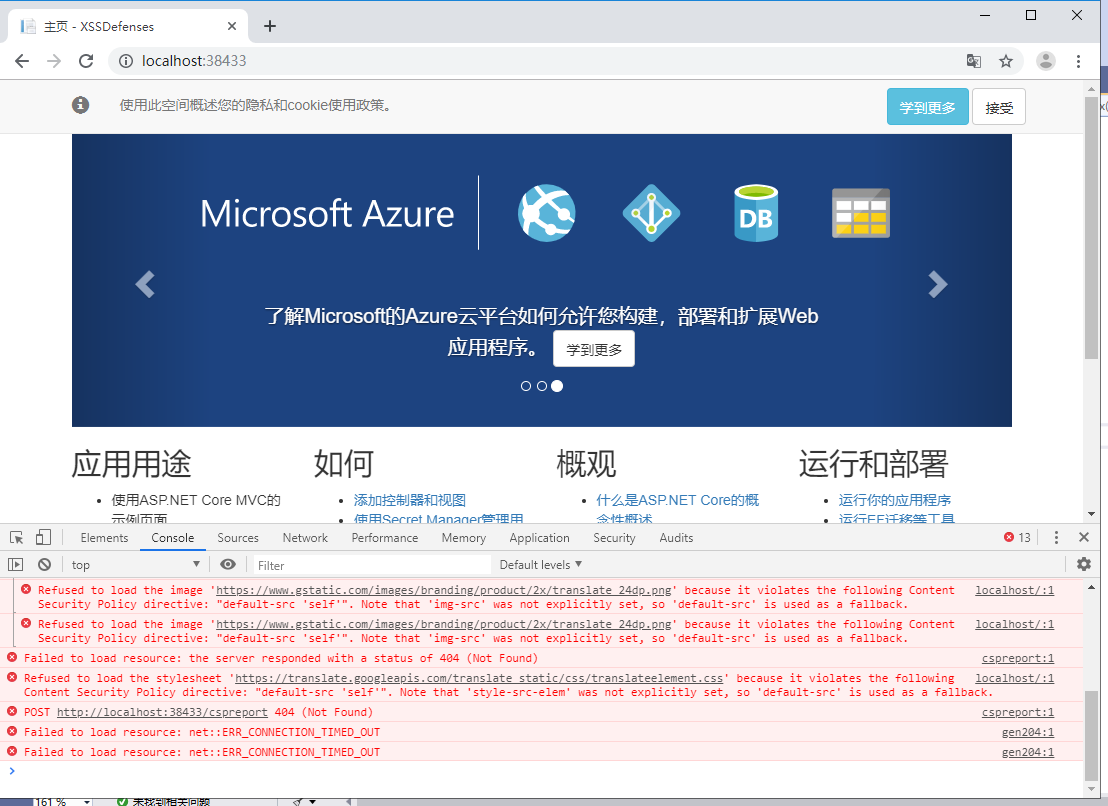ASP.NET Core中怎样利用Csp标头对抗Xss攻击
人气:0内容安全策略(CSP)是一个增加的安全层,可帮助检测和缓解某些类型的攻击,包括跨站点脚本(XSS)和数据注入攻击。这些攻击用于从数据窃取到站点破坏或恶意软件分发的所有内容(深入CSP)
简而言之,CSP是网页控制允许加载哪些资源的一种方式。例如,页面可以显式声明允许从中加载JavaScript,CSS和图像资源。这有助于防止跨站点脚本(XSS)攻击等问题。
它也可用于限制协议,例如限制通过HTTPS加载的内容。CSP通过 Content-Security-Policy HTTP响应中的标头实现。
启用CSP,您需要配置Web服务器以返回Content-Security-Policy HTTP标头。那么在这篇文章中,我们将要尝试将CSP添加到ASP.NET Core应用程序中。
app.Use(async (ctx, next) =>
{
ctx.Response.Headers.Add("Content-Security-Policy",
"default-src 'self'; report-uri /cspreport");
await next();
});
在Home/Index中引入cdn文件,然后我们启动项目,看看会发生什么!

运行并观察错误。加载页面时,浏览器拒绝从远程源加载。

所以我们可以组织CSP来控制我们的白名单,在配置当中需要填写来源以及内容,以下是常用限制的选项。
来源:
*: 允许任何网址。
‘self': 允许所提供页面的来源。请注意,单引号是必需的。
‘none': 不允许任何来源。请注意,单引号是必需的。
Host: 允许指定的互联网主机(按名称或IP地址)。通配符(星号字符)可用于包括所有子域,例如http://*.foo.com
‘unsafe-line': 允许内联脚本
‘nonce-[base64-value]': 允许具有特定nonce的内联脚本(使用一次的数字)。对于每个HTTP请求/响应,应该对nonce进行加密和唯一。
指令:
script-src:定义有效的JavaScript源
style-src:定义样式表的有效来源
img-src:定义有效的图像源
connect-src:定义可以进行AJAX调用的有效源
font-src:定义有效的字体来源
object-src:定义<object>,<embed>和<applet>元素的有效源
media-src:定义有效的音频和视频源
form-action:定义可用作HTML <form>操作的有效源。
default-src:指定加载内容的默认策略
我们可以在可重用的中间件中封装构建和添加CSP头。以下是一个让您入门的示例。你可以根据需要扩展它。首先,创建一个用于保存源的类。
public class CspOptions
{
public List<string> Defaults { get; set; } = new List<string>();
public List<string> Scripts { get; set; } = new List<string>();
public List<string> Styles { get; set; } = new List<string>();
public List<string> Images { get; set; } = new List<string>();
public List<string> Fonts { get; set; } = new List<string>();
public List<string> Media { get; set; } = new List<string>();
}
开发一个中间件一定是需要一个构造器的,这将用于.net core 的注入到运行环境中。
public sealed class CspOptionsBuilder
{
private readonly CspOptions options = new CspOptions();
internal CspOptionsBuilder() { }
public CspDirectiveBuilder Defaults { get; set; } = new CspDirectiveBuilder();
public CspDirectiveBuilder Scripts { get; set; } = new CspDirectiveBuilder();
public CspDirectiveBuilder Styles { get; set; } = new CspDirectiveBuilder();
public CspDirectiveBuilder Images { get; set; } = new CspDirectiveBuilder();
public CspDirectiveBuilder Fonts { get; set; } = new CspDirectiveBuilder();
public CspDirectiveBuilder Media { get; set; } = new CspDirectiveBuilder();
internal CspOptions Build()
{
this.options.Defaults = this.Defaults.Sources;
this.options.Scripts = this.Scripts.Sources;
this.options.Styles = this.Styles.Sources;
this.options.Images = this.Images.Sources;
this.options.Fonts = this.Fonts.Sources;
this.options.Media = this.Media.Sources;
return this.options;
}
}
public sealed class CspDirectiveBuilder
{
internal CspDirectiveBuilder() { }
internal List<string> Sources { get; set; } = new List<string>();
public CspDirectiveBuilder AllowSelf() => Allow("'self'");
public CspDirectiveBuilder AllowNone() => Allow("none");
public CspDirectiveBuilder AllowAny() => Allow("*");
public CspDirectiveBuilder Allow(string source)
{
this.Sources.Add(source);
return this;
}
}
好了,我们创建一个中间件。
namespace XSSDefenses.XSSDefenses.MiddlerWare
{
public sealed class CspOptionMiddlerWare
{
private const string HEADER = "Content-Security-Policy";
private readonly RequestDelegate next;
private readonly CspOptions options;
public CspOptionMiddlerWare(
RequestDelegate next, CspOptions options)
{
this.next = next;
this.options = options;
}
public async Task Invoke(HttpContext context)
{
context.Response.Headers.Add(HEADER, GetHeaderValue());
await this.next(context);
}
private string GetHeaderValue()
{
var value = "";
value += GetDirective("default-src", this.options.Defaults);
value += GetDirective("script-src", this.options.Scripts);
value += GetDirective("style-src", this.options.Styles);
value += GetDirective("img-src", this.options.Images);
value += GetDirective("font-src", this.options.Fonts);
value += GetDirective("media-src", this.options.Media);
return value;
}
private string GetDirective(string directive, List<string> sources)
=> sources.Count > 0 ? $"{directive} {string.Join(" ", sources)}; " : "";
}
}
以及设置它的扩展方法。
namespace XSSDefenses.XSSDefenses.Extensions
{
public static class CspMiddlewareExtensions
{
public static IApplicationBuilder UseCsp(
this IApplicationBuilder app, Action<CspOptionsBuilder> builder)
{
var newBuilder = new CspOptionsBuilder();
builder(newBuilder);
var options = newBuilder.Build();
return app.UseMiddleware<CspOptionMiddlerWare>(options);
}
}
}
我们现在可以在Startup类中配置中间件。
app.UseCsp(builder =>
{
builder.Styles.AllowSelf()
.Allow(@"https://ajax.aspnetcdn.com/");
});
启动发现,观察网络资源。浏览器已经允许本地和远程资源。

总结
以上就是这篇文章的全部内容了,希望本文的内容对大家的学习或者工作具有一定的参考学习价值,谢谢大家对的支持。
您可能感兴趣的文章:
加载全部内容